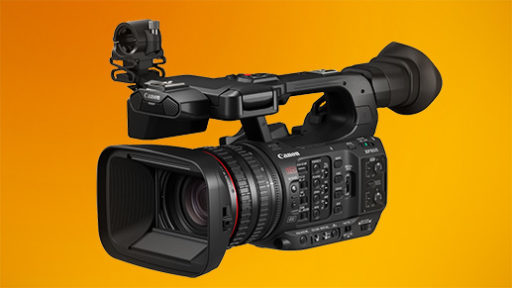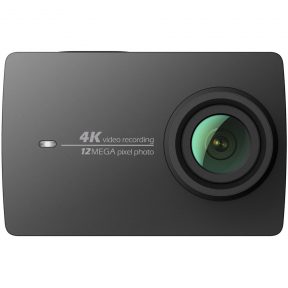Canon R5C - A True Hybrid Camera?
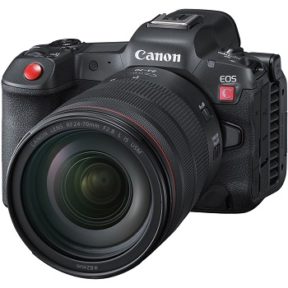 The Canon EOS R5C was recently announced and it seems like it is a huge surprise to most filmmakers, videographers, cinematographers, content creators, or whatever you may be calling yourself these days. Many thought it was simply going to be the Canon R5 rebadged as a ‘C’ version with some different firmware and a way to stop it from over-heating while shooting video. And yes, those two things are true, but this camera is a bit more than that. And at the time of writing this, it is only $4,499. Click here for current pricing. The following are some of the stand-out features of this camera and the one huge thing that makes it very unique. Of course there are always cons. There truly is no perfect camera, but we will take a look at those things as well.
The Canon EOS R5C was recently announced and it seems like it is a huge surprise to most filmmakers, videographers, cinematographers, content creators, or whatever you may be calling yourself these days. Many thought it was simply going to be the Canon R5 rebadged as a ‘C’ version with some different firmware and a way to stop it from over-heating while shooting video. And yes, those two things are true, but this camera is a bit more than that. And at the time of writing this, it is only $4,499. Click here for current pricing. The following are some of the stand-out features of this camera and the one huge thing that makes it very unique. Of course there are always cons. There truly is no perfect camera, but we will take a look at those things as well.
Stand Out Features
1. 8k @ 60fps Internally
This is the headline feature of this camera, so I’ll mention it first. You can shoot in 8k all the way up to 60fps. But not only that, you can do it in 12-bit Raw Lite internally to a CF express card. No external recorder required. However, there is a caveat to shooting in this format internally, and we’ll go over that when we speak about some of the cons of the camera. It is also important to note that the camera is capable of recording in 4k @120fps. There is no audio in this mode, however a separate audio file is created in the camera, and will need to be synced while editing. It’s still pretty cool that it has this capability.
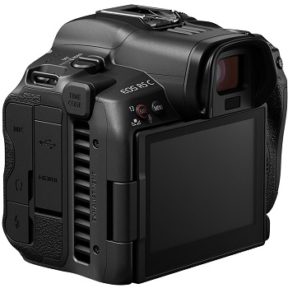 The Canon R5C is a bit deeper than the original R5 to allow for a cooling fan, so that 8k, 5.9k, 4k or whatever resolution you choose to shoot in will not overheat. Not only that, but there are no record limits to your video at all. Feel free to record until your card is filled or your battery runs out. The fan is not loud and you can control the intensity of the fan or leave it on auto. Also despite the vents, the Canon R5C is still moisture and dust resistant.
The Canon R5C is a bit deeper than the original R5 to allow for a cooling fan, so that 8k, 5.9k, 4k or whatever resolution you choose to shoot in will not overheat. Not only that, but there are no record limits to your video at all. Feel free to record until your card is filled or your battery runs out. The fan is not loud and you can control the intensity of the fan or leave it on auto. Also despite the vents, the Canon R5C is still moisture and dust resistant.
3. Dual ISO
The Canon R5C comes with Dual Native ISO and the native ISOs are either 800 or 3200. This means your best clearest shots will be achieved at 800 ISO and again at 3200 ISO, and it also means that the low light performance in this camera is excellent.
4. Great Auto Focus
This one pretty much goes without saying because Canon cameras have been known for this for about a decade or so, but of course the Auto Focus is excellent due to Canon’s Dual Pixel Auto Focus. In video mode you have Face Tracking, and Head and Eye Tracking to make sure that you won’t lose your focus for those critical shots. For stills there is also Animal and Vehicle detection as well. I’m not sure if either works in video mode.
5. Professional Audio Adapter
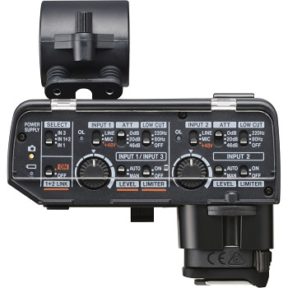 There is a headphone jack and 3.5mm mic jack that are built into the camera, but along with that there is a hot shoe that will allow you to attach the Tascam CA-XLR2d-C XLR Microphone Adapter Kit. This adapter gives you two xlr inputs with access to 48v phantom power. The adapter only uses two AA batteries. This is a good thing because it isn’t drawing power from the camera. We’ll talk about battery limitations a little later
There is a headphone jack and 3.5mm mic jack that are built into the camera, but along with that there is a hot shoe that will allow you to attach the Tascam CA-XLR2d-C XLR Microphone Adapter Kit. This adapter gives you two xlr inputs with access to 48v phantom power. The adapter only uses two AA batteries. This is a good thing because it isn’t drawing power from the camera. We’ll talk about battery limitations a little later
6. Professional Video Tools
There’s nothing like having professional tools for getting your focus or getting the proper exposure for your shots, and the Canon R5 C has all of those things. Of course you have focus peaking to help you nail your focus, but then you also have Waveform, Zebras, and False Color to help you get your exposure. You even have a Vectorscope to check your colors. These tools are not too common in other mirrorless cameras, but that’s the thing. This really isn’t a typical mirrorless camera, and that is why it is part of the cinema line. And I’ve saved the best feature for last. This is the one that truly makes this the first real hybrid camera in my opinion.
7. A Toggle for Video and Photo mode
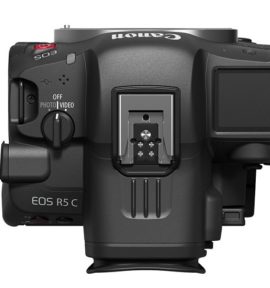 And here it is….this is by far the coolest feature about this camera. It has a toggle for video and photo mode. I know… queue the “Price Is Right” loser horn. You’re probably thinking, “That isn’t a big deal other cameras have a dial for video mode and then the several other photo modes.” Yes, that’s true, but they don’t truly work like the Canon R5 C. This camera when switched to video will only have button functions and menu options that are used specifically for video. I can’t tell you how many mirrorless cameras I have used that have convoluted menus that contain both video settings and photo settings crammed in. It makes it so difficult to find things depending on what you are doing. If I am shooting video, I don’t want to control my picture bracketing settings, nor do I want to control my flash settings. Or if I am shooting video, I don’t want to mess with my audio controls or adjust whether I am shooting 4:2:2 or 4:2:0. I think this is a great feature that will make the camera a lot more user friendly. And on top of that you have a power house camera that can shoot in 8k for video and up to 45MP for photos. Alright now that we’ve talked about the good stuff. Let’s talk a bit about the bad stuff.
And here it is….this is by far the coolest feature about this camera. It has a toggle for video and photo mode. I know… queue the “Price Is Right” loser horn. You’re probably thinking, “That isn’t a big deal other cameras have a dial for video mode and then the several other photo modes.” Yes, that’s true, but they don’t truly work like the Canon R5 C. This camera when switched to video will only have button functions and menu options that are used specifically for video. I can’t tell you how many mirrorless cameras I have used that have convoluted menus that contain both video settings and photo settings crammed in. It makes it so difficult to find things depending on what you are doing. If I am shooting video, I don’t want to control my picture bracketing settings, nor do I want to control my flash settings. Or if I am shooting video, I don’t want to mess with my audio controls or adjust whether I am shooting 4:2:2 or 4:2:0. I think this is a great feature that will make the camera a lot more user friendly. And on top of that you have a power house camera that can shoot in 8k for video and up to 45MP for photos. Alright now that we’ve talked about the good stuff. Let’s talk a bit about the bad stuff.
The Negatives
And now we get to some of the bad things about this camera, and honestly they really aren’t that major in my opinion. Well…except for this first one.
1. No ND filters
To me this is the biggest problem. It’s a cinema camera, but there aren’t any ND filters. I guess technically speaking, there is no need to have ND filters to be considered a cinema camera. What does cinema camera really mean anyway? Does it mean interchangeable, a big sensor camera with more advanced video codecs? Who knows. That’s a whole other blog. I wish it had ND filters. It certainly makes shooting run-and-gun material much easier.
2. Micro HDMI
Unfortunately there is not a full HDMI port on this camera – only micro, so you best have a couple of spares with you because as we all know these break very easily.
3. No XLR inputs on the camera
I know this is a bit strange to have listed as a negative since I mentioned the XLR adapter from Tascam earlier. However, I would have loved to see a detachable handle from Canon that was not just two XLR inputs, but an actual handle that can be used for mounting the camera onto tripods or for getting lower angle shots. If you have used cameras with XLR handles, you know how useful they can be. It’s the simple things in life that put a smile on my face. You know what I mean?
4. No IBIS
There is no In Body Image Stabilization in this camera. In other words the sensor doesn’t float around to aid you with your handheld shaky footage. However there is electronic image stabilization that isn’t all the bad. I personally understand this choice. Floating sensors work well for certain things but not others. If you want to hand hold the camera and try to look as if you are on a tripod, they can work well. If you want to do a small pan or tilt the same thing. But get anymore movement in there and things look extra wobbly. I also find that when you don’t use native lenses with a camera, you may get some bad results. Even more so, then having a fixed sensor with standard lens stabilization.
5. So So Battery Life
The Canon R5C uses the LP-E6N batteries, so the battery life is not the best. From tests that I’ve seen, it will record about 1 hr of 8k footage. Honestly, that doesn’t sound too bad to me. The other problem is that if you want to shoot in 8k @ 60 fps, the stock battery will not do that and power an electronic lens at the same time. In order to do that, you have to use the usb-c port with an external battery or you can use a dummy battery and plug the camera into wall power with a canon ac adapter. I’m going to be honest with you, I don’t think a tremendous amount of people are shooting in 8k anyway.
Conclusion:
That’s all. For $4,499 this is an impressive camera. It really is like having two cameras in one. And whether you are shooting photos or video, you have an impressive machine that can make some beautiful images. For most current pricing be sure to check here: Canon R5 C

